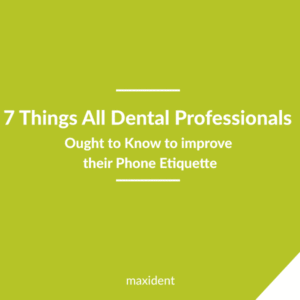
As a dental professional, the first and most important focus should be your patients. Whether new or returning, patients are what make your dental practice a success. And one of the skills required to make sure your patients get exactly what they need from you is, of course, the ability to effectively communicate. According to Larry M. Guzzardo, “Dentistry is a service business, and communication is paramount to success.”
However, communication is not limited to face-to-face interaction where body language and facial expression play a huge part; it is also imperative to have proper phone etiquette. With this skill you can convince your patients to ask questions and open up to you without feeling judged or scrutinized or even like their opinions don’t matter. With proper phone etiquette, your patients will learn to trust and confide in you, making it that much easier for you to give them the proper mouth care. Provided below are seven things all dental professionals should know to improve phone etiquette and become a much better listener.
- Ask open-ended questions
Open-ended questions are those questions that can’t be answered with a simple yes or no. They encourage the speakers to engage. The point of you asking these types of questions is to expand on your patients’ thoughts and concepts. You want to keep the conversation moving forward and this can only be achieved by asking questions that allow the patient to direct the conversation. One question will lead to another, allowing you to achieve a greater understanding of what that particular patient needs.
- Resist the urge to dominate the conversation
You want the conversation to develop a natural ebb and flow with each question only helping to clarify what your patient is saying. You want to avoid taking over and interrupting the conversation with your own ideas and viewpoints. Your contributions should be short and to the point, allowing both you and your patient the opportunity to talk. Your manner should be low-key, easy going, cheerful, and you should seem genuinely interested in what your patient has to say.
- Be active and engaged in the conversation
To be active and engaged without being pushy or domineering, you can say things like, “oh” or “hmm” or “I see.” These acceptance phrases assure your patient that you are listening and willing to understand, and even empathize with, their viewpoint.
- Listen attentively and without interruption
Listening to what your patient has to say without interrupting, tells him or her that you value what they have to say and, in return, they will respond warmly and openly to you. Sometimes, it can be hard to resist giving your two cents and therefore, you find yourself preparing to jump in before your patient has finished speaking. Your two cents can wait. Listen first and make sure you’ve heard and understood what your patient is saying. Barreling forward with your own opinions can reduce your ability to really listen and can potentially damage your counterargument.
- Stay calm and cool
Some patients can be a handful and have to be handled with kid gloves, but these patients deserve just as much respect and care as the others. It is important to remember to stay calm and cool and just let the patient vent. Don’t take anything they say personally. You are not being attacked. You want to make these patients feel that their concerns are legitimate, and if you stay calm and listen, the patient’s stress-level will come down, making it easier for the two of you to communicate rationally.
- Paraphrase the speaker’s words
This is an important quality related to active listening techniques. Don’t automatically assume you know exactly what the patient is talking about; instead, say something like, “Let me see if I understand you correctly” and rephrase what they’ve told you in your own words. This will help you to understand the situation and it might even help the patient better understand it as well.
- Always pause before replying
When you pause to let the other person finish their thought and give them a chance to catch their breath, you can actually kill three birds with one stone by
- avoiding running the risk of interrupting.
- showing that you give your patients’ concerns careful consideration.
- helping yourself understand what the patient is saying with greater and deeper clarity.
The most important part of developing and maintaining excellent phone etiquette is your ability to listen. Your mind can process five times more words per minute than you can talk, so it takes a real effort to keep your attention focused on the words of others. This is why practicing active listening with your patients is so important. Listening actively builds trust and self-esteem in your patients but it also builds your own self-discipline when it comes to being attentive to that patient on the other end.
Come and join this conversation. Let us know what techniques work best for you and add your own opinions and ideas to this list.
Suggested Page



